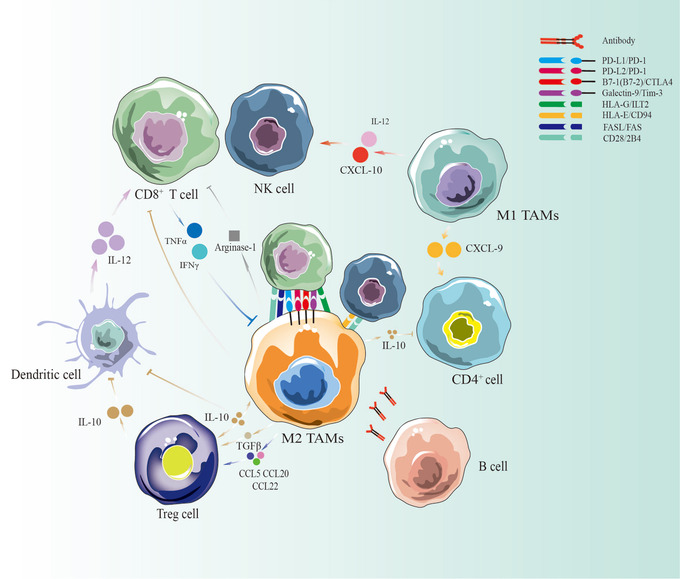FIGURE 5.

TAMs coordinate with other immune cells in liver cancer. TAMs may be considered a double‐edged sword in the immune microenvironment of liver cancer. M2 macrophages and Tregs can secrete IL‐10 to inhibit DCs, T cells and NK cells. They can also secrete arginase and directly contact each other to inhibit the immune response. M1 macrophages can secrete IL‐12 and CXCL10 to recruit more T cells and NK cells, whereas CXCL9 derived from M1 macrophages can stimulate CD4+ T cells. B cells participate in anti‐tumor‐related macrophage activities by secreting antibodies. Abbreviations: TAMs, tumor‐associated macrophages; M1 TAMs, M1 type tumor‐associated macrophages; M2 TAMs, M2 type tumor‐associated macrophages; HCC, hepatocellular carcinoma; NK cell, natural killer cell; IL‐10, interleukin 10; IL‐12, interleukin 12; CCL5, C‐C motif chemokine ligand 5; CCL20, C‐C motif chemokine ligand 20; CCL22, C‐C motif chemokine ligand 22; TNF‐α, tumor necrosis factor α; TGF‐β, transforming growth factor‐β; IFNγ, interferon‐gamma; CXCL9, C‐X‐C motif chemokine ligand 9; CXCL10, C‐X‐C motif chemokine ligand 10; PD‐L1, programmed cell death protein 1 ligand 1; PD‐1, programmed cell death protein 1; CTLA‐4, cytotoxic T‐lymphocyte antigen 4; HLA‐E, human leukocyte antigen E; HLA‐G, human leukocyte antigen G; ILT2, Ig‐like transcript 2; FAS, factor‐related apoptosis; FASL, factor‐related apoptosis ligand
